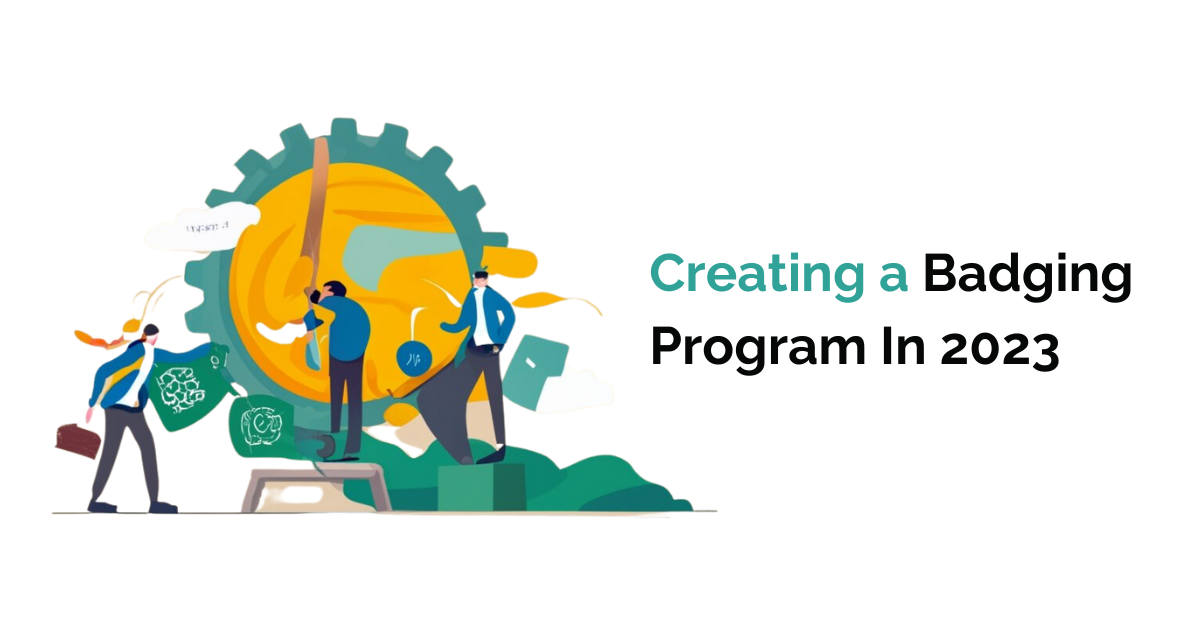Creating a Badging Program In 2023
To recognizing and showcasing one’s achievements and skills has evolved beyond the traditional certificate or diploma. Digital badges, often referred to as “digital badging,” have become a prevalent means of acknowledging accomplishments in various fields. In this article, we will explore the world of digital badges, from designing a badge program to its successful implementation.
Stage 1: System Design
As the use of digital badges continues to grow, it is essential to plan and design a robust system to accommodate both badges and earners efficiently. This stage forms the foundation for a successful badging program.

-
System’s Reach: Start Small, Think Big
Determining which competencies to represent is a crucial step in the badging process. Starting small by focusing on a few core skills allows for a more manageable launch. Consider the potential for future growth and expansion. -
Workflow Matters: Streamlining Badge Issuance
Designing an efficient workflow for badge issuance is key to ensuring a smooth process for both earners and evaluators. Integrating the evaluation process into existing workflows and defining how participants will find and earn badges is essential. -
Identify Participants and Resources
Define the target audience for your badge program and anticipate changes in administration. Consider the resources required, including financial support, personnel, and training for badge evaluators.
Stage 2: Designing the Badges
The heart of any digital badge program lies in the design of the badges themselves. A well-designed badge not only looks appealing but also effectively communicates the skills and achievements it represents.

-
Badge Range:
Digital badges can represent a wide range of abilities or experiences, but they are often designed to spotlight specific personal talents or achievements. Define the scope and focus of your badges. -
Metadata Matters:
Each digital badge contains metadata, including the badge’s name, description, issuer details, and more. Ensure that the metadata fields are well-defined and informative, aiding earners in understanding the badge’s significance. -
Picture-Perfect Badges:
The badge’s image is the first thing earners and viewers see. Invest time in creating visually appealing badge images that enhance the overall credibility of your program. -
Educational Resources:
While badges outline requirements and competencies, they typically do not provide instructions on how to achieve them. Consider offering additional educational resources or references to assist earners in acquiring the necessary skills. -
Team Collaboration:
In many badge systems, badges are created and managed by a team. Establish clear guidelines and training for badge designers to maintain uniformity and quality in badge designs.
Stage 3: Publication
Once your badges are designed, it’s time to publish and distribute them to your intended audience. Selecting the right platform for issuing badges is crucial in this stage.
-
Selecting the Platform: Choosing the Right Fit
Various badge platforms are available, each with its unique features. Evaluate multiple platforms to find the one that aligns with your program’s goals and integrates smoothly with your existing tools. Eg: CertifyMe -
Workflow Testing: Ensure Smooth Badge Issuance
Before finalizing your platform choice, create and issue a few badges as a test. Verify that the platform supports your workflow and meets your requirements. -
Permissions and Costs: Consider the Practicalities
Badge platforms often offer different permission levels and pricing structures. Assess the platform’s cost, considering potential expansion, and ensure that it meets your organization’s needs.
Stage 4: Change Management
Implementing a badge program often necessitates cultural and organizational change. These strategies can help facilitate a smooth transition.
-
Badge Champion: Leading the Way
Appoint a dedicated member of your organization to champion the badge program’s design and implementation. This role ensures coordination and oversight throughout the process. -
Engage Earners: Involve Them in the Process
Engage potential earners in the badge design process, gather feedback, and iterate based on their input. Encourage earners to apply for badges based on their prior work and experience. -
Prioritize the Consumer: Collaboration is Key
To ensure that badge consumers accept and value them, involve them in the badge creation process. Incorporate their feedback early to enhance the badge’s comprehensibility and meaning. -
Metadata Clarity: Enhancing Consumer Understanding
Ensure that the metadata associated with each badge is clear and easily understandable to outside audiences. Provide brief explanations of the review process and expected work levels to enhance consumer acceptance.
Conclusion
Creating a successful badge program involves careful planning, thoughtful design, and effective implementation. By following the stages outlined in this article, organizations can harness the potential of digital badges to acknowledge and celebrate accomplishments in the digital age. Whether you are an educational institution, a professional organization, or a business, digital badges offer a versatile and modern way to acknowledge and promote excellence. Embrace the world of digital badging and empower your learners, members, and employees to showcase their skills and achievements with pride.

 Author :
Author : 







